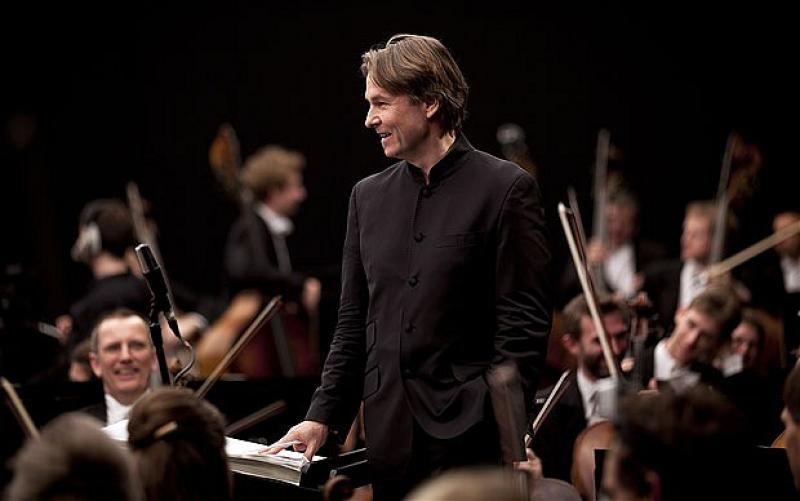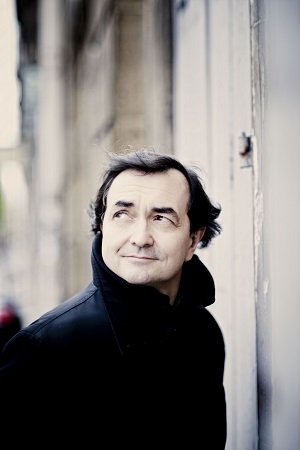Aimard, Philharmonia, Salonen, RFH | reviews, news & interviews
Aimard, Philharmonia, Salonen, RFH
Aimard, Philharmonia, Salonen, RFH
Unearthed Stravinsky is a revelation, while Ligeti and Ravel dazzle

A new work by Igor Stravinsky is always going to be a major event, so Sunday evening’s UK premiere of his rediscovered Funeral Song was hotly anticipated.
Funeral Song is an early work, dating from 1908, but it’s not juvenilia. Written as a memorial to Stravinsky’s teacher, Rimsky-Korsakov, the music seems to consciously imitate his style, especially his rich orchestral colours and bold but constantly shifting harmonies. There is little of Stravinsky’s later rhythmic sophistication, but the orchestration is as masterful as that of his Diaghilev ballets. In later life, Stravinsky recalled “the idea ... was that all the solo instruments of the orchestra filed past the tomb of the master in succession”. And so it proves, with a graceful three-bar theme, first introduced in the solo horn and then passed around the soloists and instrumental sections.
Given Stravinsky’s later penchant for revision, he may have revisited the work's ending had he the chance – a huge cut off at the climax seems needlessly jarring, and the coda lacks coherence, with unrelated harmonies juxtaposed from different sections of the orchestra. But this performance was excellent, especially given the lack of performing tradition for the work. Esa-Pekka Salonen took a patient but focussed approach, stringing the successive statements of the melody into long, unbroken lines and carefully building to the work’s climax.
 The lightness and whimsy of Ligeti’s Piano Concerto provided ideal contrast to the sombre opener. Pianist Pierre-Laurent Aimard (pictured left by Marco Borggreve) is closely associated with the work, as is Salonen with all of Ligeti’s orchestral music, so expectations ran high, and were not disappointed. Salonen opted for the chamber version of the work, with just five strings, a wise choice, as the balance here was ideal, weighed more towards the winds and percussion, and allowing more space for the introverted and busy piano part. The precision of the Philharmonia’s playing was never in doubt, but Salonen avoided making the textures too fussy or clean – something the composer himself also ensures by often doubling the woodwind lines with ocarina and swanee whistle. The two percussionists were unfortunately positioned behind the piano and obscured by the raised lid, making the vast array of bizarre sounds they produced all the more intriguing and mysterious. Best of all was Aimard, whose darting, mischievous movements around the keyboard are ideal for Ligeti’s playful and complex lines. Again, there was a sense here that, for all his consummate mastery, Aimard was careful to maintain the messy and anarchic character of the work – his perfection was unquestionable, but somehow he made it seem accidental too.
The lightness and whimsy of Ligeti’s Piano Concerto provided ideal contrast to the sombre opener. Pianist Pierre-Laurent Aimard (pictured left by Marco Borggreve) is closely associated with the work, as is Salonen with all of Ligeti’s orchestral music, so expectations ran high, and were not disappointed. Salonen opted for the chamber version of the work, with just five strings, a wise choice, as the balance here was ideal, weighed more towards the winds and percussion, and allowing more space for the introverted and busy piano part. The precision of the Philharmonia’s playing was never in doubt, but Salonen avoided making the textures too fussy or clean – something the composer himself also ensures by often doubling the woodwind lines with ocarina and swanee whistle. The two percussionists were unfortunately positioned behind the piano and obscured by the raised lid, making the vast array of bizarre sounds they produced all the more intriguing and mysterious. Best of all was Aimard, whose darting, mischievous movements around the keyboard are ideal for Ligeti’s playful and complex lines. Again, there was a sense here that, for all his consummate mastery, Aimard was careful to maintain the messy and anarchic character of the work – his perfection was unquestionable, but somehow he made it seem accidental too.
For the second half, Ravel’s Daphnis and Chloe. Performing the full ballet rather than the usual concert suites emphasised Ravel’s innate sense for musical storytelling, and his masterly orchestration meant that nothing here ever felt redundant. Salonen’s ability to think in long spans, even through numerous time changes in quick succession, impressively maintained the focus. Projecting the section titles from the ballet above the orchestra seemed a distraction to begin with, but it served to demonstrate the composer’s attention to detail in reflecting every element of the onstage action in the score.
The Philharmonia always plays well for Salonen, but they were on particularly fine form for this evening’s varied and demanding programme. The orchestra was particularly impressive in the Ravel. The score belongs to the flute section, who all excelled, particularly principal Samuel Coles and alto Karen Jones. Excellent cor anglais solos too, from Jill Crowther. And a lush, radiant string tone, particularly glowing in the "Daybreak" sequence. Add to that fine performances from the two choruses, the Philharmonia Voices and the Rudolfus Choir (even when amassed, still modest in number) and the result was a Daphnis very close to perfection.
- This concert was recorded for BBC Radio 3 and will be broadcast on Friday 24 February
- Read more classical music reviews on theartsdesk
rating
Share this article
The future of Arts Journalism
You can stop theartsdesk.com closing!
We urgently need financing to survive. Our fundraising drive has thus far raised £33,000 but we need to reach £100,000 or we will be forced to close. Please contribute here: https://gofund.me/c3f6033d
And if you can forward this information to anyone who might assist, we’d be grateful.

Subscribe to theartsdesk.com
Thank you for continuing to read our work on theartsdesk.com. For unlimited access to every article in its entirety, including our archive of more than 15,000 pieces, we're asking for £5 per month or £40 per year. We feel it's a very good deal, and hope you do too.
To take a subscription now simply click here.
And if you're looking for that extra gift for a friend or family member, why not treat them to a theartsdesk.com gift subscription?
more Classical music
 Classical CDs: Romance, reforestation and a Rolleiflex
New music for choir, orchestra and string quartet, plus a tribute to a rediscovered photographer
Classical CDs: Romance, reforestation and a Rolleiflex
New music for choir, orchestra and string quartet, plus a tribute to a rediscovered photographer
 Donohoe, RPO, Brabbins, Cadogan Hall review - rarely heard British piano concerto
Welcome chance to hear a Bliss rarity alongside better-known British classics
Donohoe, RPO, Brabbins, Cadogan Hall review - rarely heard British piano concerto
Welcome chance to hear a Bliss rarity alongside better-known British classics
 London Choral Sinfonia, Waldron, Smith Square Hall review - contemporary choral classics alongside an ambitious premiere
An impassioned response to the climate crisis was slightly hamstrung by its text
London Choral Sinfonia, Waldron, Smith Square Hall review - contemporary choral classics alongside an ambitious premiere
An impassioned response to the climate crisis was slightly hamstrung by its text
 Goldberg Variations, Ólafsson, Wigmore Hall review - Bach in the shadow of Beethoven
Late changes, and new dramas, from the Icelandic superstar
Goldberg Variations, Ólafsson, Wigmore Hall review - Bach in the shadow of Beethoven
Late changes, and new dramas, from the Icelandic superstar
 Mahler's Ninth, BBC Philharmonic, Gamzou, Bridgewater Hall, Manchester review - vision and intensity
A composer-conductor interprets the last completed symphony in breathtaking style
Mahler's Ninth, BBC Philharmonic, Gamzou, Bridgewater Hall, Manchester review - vision and intensity
A composer-conductor interprets the last completed symphony in breathtaking style
 St Matthew Passion, Dunedin Consort, Butt, Queen’s Hall, Edinburgh review - life, meaning and depth
Annual Scottish airing is crowned by grounded conducting and Ashley Riches’ Christ
St Matthew Passion, Dunedin Consort, Butt, Queen’s Hall, Edinburgh review - life, meaning and depth
Annual Scottish airing is crowned by grounded conducting and Ashley Riches’ Christ
 St Matthew Passion, Irish Baroque Orchestra, Whelan, St Patrick’s Cathedral, Dublin review - the heights rescaled
Helen Charlston and Nicholas Mulroy join the lineup in the best Bach anywhere
St Matthew Passion, Irish Baroque Orchestra, Whelan, St Patrick’s Cathedral, Dublin review - the heights rescaled
Helen Charlston and Nicholas Mulroy join the lineup in the best Bach anywhere
 Kraggerud, Irish Chamber Orchestra, RIAM Dublin review - stomping, dancing, magical Vivaldi plus
Norwegian violinist and composer gives a perfect programme with vivacious accomplices
Kraggerud, Irish Chamber Orchestra, RIAM Dublin review - stomping, dancing, magical Vivaldi plus
Norwegian violinist and composer gives a perfect programme with vivacious accomplices
 Small, Hallé, Wong, Bridgewater Hall, Manchester review - return to Shostakovich’s ambiguous triumphalism
Illumination from a conductor with his own signature
Small, Hallé, Wong, Bridgewater Hall, Manchester review - return to Shostakovich’s ambiguous triumphalism
Illumination from a conductor with his own signature
 LSO, Noseda, Barbican review - Half Six shake-up
Principal guest conductor is adrenalin-charged in presentation of a Prokofiev monster
LSO, Noseda, Barbican review - Half Six shake-up
Principal guest conductor is adrenalin-charged in presentation of a Prokofiev monster
 Frang, LPO, Jurowski, RFH review - every beauty revealed
Schumann rarity equals Beethoven and Schubert in perfectly executed programme
Frang, LPO, Jurowski, RFH review - every beauty revealed
Schumann rarity equals Beethoven and Schubert in perfectly executed programme
 Levit, Sternath, Wigmore Hall review - pushing the boundaries in Prokofiev and Shostakovich
Master pianist shines the spotlight on star protégé in another unique programme
Levit, Sternath, Wigmore Hall review - pushing the boundaries in Prokofiev and Shostakovich
Master pianist shines the spotlight on star protégé in another unique programme

Add comment